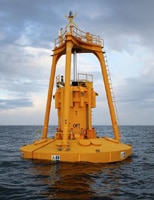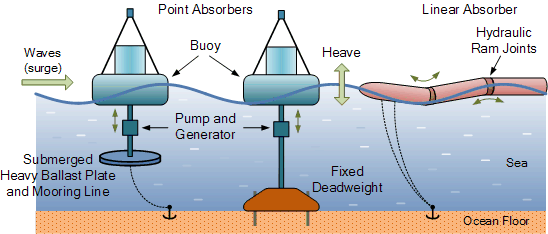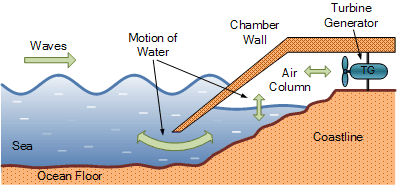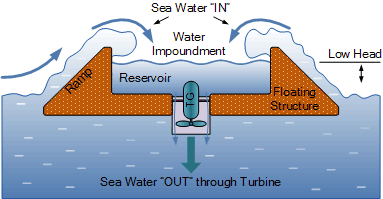
Wave Energy Devices
Devices that Harness the Energy of the Waves
![]() The amount of power available in the movement of ocean waves has inspired many engineers to develop machines and devices to capture and use this free oceanic power. In certain parts of the world’s oceans the amount of wave energy is vast, so the development of wave energy devices to exploit the the inherent oscillatory nature of ocean waves for electrical energy generation.
The amount of power available in the movement of ocean waves has inspired many engineers to develop machines and devices to capture and use this free oceanic power. In certain parts of the world’s oceans the amount of wave energy is vast, so the development of wave energy devices to exploit the the inherent oscillatory nature of ocean waves for electrical energy generation.
We have seen previously that Wave Energy is a non-polluting and renewable source of energy, created by natural transfer of wind energy above the oceans, which itself is created by the effects of the suns solar energy. As the wind blows across the oceans surface, moving air particles transfer their energy to the water molecules that they touch.
As the wind continues to blow more and more of its kinetic energy is transferred to the oceans surface and the waves grow bigger. These larger waves are called gravity waves because their potential energy is due to the gravitational force of the Earth. There is a lot of potential energy in the waves generated by the wind, to the point were large storm waves can lift ships high out of the water.
As an ocean wave passes a stationary position the surface of the sea changes in height, water near the surface moves as it losses its kinetic and potential energy, which affects the pressure under the surface. The periodic or oscillatory nature of ocean waves means that we can use a variety of different Wave Energy Devices to harness the energy produced by the oceans waves.
The problem lies in that the oscillatory frequency of an ocean wave is relatively slow and is much less than the hundreds of revolutions per minute required for electric power generation. Then a great variety of wave energy devices and designs are available to convert these slow-acting, reversing wave forces into the high speed, unidirectional rotation of a generator shaft.
There are three fundamental but very different wave energy devices used in converting the ocean wave power into electric power, and these are:
- Wave Profile Devices These are wave energy devices which turn the oscillating height of the oceans surface into mechanical energy.
- Oscillating Water Columns These are wave energy devices which convert the energy of the waves into air pressure.
- Wave Capture Devices These are wave energy devices which convert the energy of the waves into potential energy.
Wave Profile Devices
Wave profile devices are a class of wave energy device which floats on or near to the sea surface and moves in response to the shape of the incident wave or, for submersible devices, it moves up and down under the influence of the variations in underwater pressure as a wave moves by.
Most types of wave profile devices float on the surface absorbing the wave energy in all directions by following the movements of waves at or near the sea surface, just like a float. The only wave energy devices that use wave profiling have been in practical use for some time, although on a fairly small-scale, are those used for powering navigation buoys.
If the physical size of the wave profile device is very small compared to the periodic length of the wave, this type of wave energy device is called a “point absorber”. If the size of the device is larger or longer than the typical periodic wavelength, it is called a “linear absorber”, but more commonly they are collectively known as “wave attenuators”.
The main difference between the two wave energy devices is how the oscillating system converts the wave energy between the absorber and a reaction point. This energy absorption can be achieved either by a floating body, an oscillating solid member or oscillating water within a buoys structure itself.
The waves energy is absorbed using vertical motion (heave), horizontal motion in the direction of wave travel (surge), angular motion about a central axis parallel to the wave crests (pitch) or angular motion about a vertical axis (yaw) or a combination of all four with the energy being generated by reacting these different movements against some kind of fixed resistance called a reaction point.
To make efficient use of the force generated by the wave, we need some kind of force reaction. In other words, we want the waves force on the float to react against another rigid or semi-rigid body. Reaction points can be inertial masses such as heavy suspended ballast plates, sea-floor anchors or a fixed dead-weight or pile as shown.
Wave Profile Devices

The pitching and heaving of the waves causes a relative motion between an absorber and reaction point. The left hand wave energy device above, uses a heavy ballast plate suspended below the floating buoy. The buoy is prevented from floating away by a mooring line attached to a sea-floor anchor. This mooring line allows the point absorber to operate offshore in deeper waters.
As the buoy bobs up-and-down in the waves, a oscillatory mutual force reaction is generated between the freely moving absorber and the heavy plate causing a hydraulic pump in between to rotate a generator producing electricity. The middle wave energy device operates in a similar manner to the previous floating buoy device.
The difference this time is that the freely heaving buoy reacts against a fixed reaction point such as a fixed dead-weight on the ocean floor. As this type of point absorber is bottom mounted, it is operated in shallower near shore locations.
The third device is an example of a linear absorber (wave attenuator) which floats on the surface of the water. It to is tethered to the ocean floor so that it can swing perpendicularly towards the incoming waves. As the waves pass along the length of this snake like wave energy device, they cause the long cylindrical body to sag downwards into the troughs of the waves and arch upwards when the waves crest is passing.
The Pelamis Wave Energy Converter
Connecting joints along the body of the device flex in the waves exerting a great deal of force which is used to power a hydraulic ram at each joint. The hydraulic ram drives oil through a hydraulic motor which drives a generator, producing the electricity.
This method of wave energy conversion is currently being used by a device called the Pelamis Wave Energy Converter developed by the “Pelamis Wave Power” company (please watch the video for more information). One advantage of the Pelamis design is that several offshore devices can be connected and linked together to the shoreline through a single submersible underwater cable and as it responds and flexes to the gentle movement of the waves, it has the potential to produce a steady and constant supply of electrical power.
Oscillating Column Wave Energy Devices
The Oscillating Water Column, (OWC) is a popular shoreline wave energy device normally positioned onto or near to rocks or cliffs which are next to a deep sea bottom. They consist of a partly submerged hollow chamber fixed directly at the shoreline which converts wave energy into air pressure.
The structure used to capture the waves energy could be a natural cave with a blow hole or a man made chamber or duct with a wind turbine generator located at the top well above the waters surface. Either way, the structure is built perpendicular to the waves with part of the ocean surface trapped inside the chamber which itself is open to the sea below the water line. The constant ebbing and flowing motion of the waves forces the trapped water inside the chamber to oscillate in the vertical up-down direction.
Oscillating Wave Column

As the incident waves outside enter and exit the chamber, changes in wave movement on the opening cause the water level within the enclosure to oscillate up and down acting like a giant piston on the air above the surface of the water, pushing it back and forth. This air is compressed and decompressed by this movement every cycle. The air is channelled through a wind turbine generator to produce electricity as shown.
The type of wind turbine generator used in an oscillating water column design is the key element to its conversion efficiency. The air inside the chamber is constantly reversing direction with every up-and-down movement of the sea water producing a sucking and blowing effect through the turbine. If a conventional turbine was used to drive the attached generator, this too would be constantly changing direction in unison with the air flow. To overcome this problem the type of wind turbine used in oscillating water column schemes is called a Wells Turbine.
The Wells turbine has the remarkable property of rotating in the same direction regardless of the direction of air flow in the column. The kinetic energy is extracted from the reversing air flow by the Wells turbine and is used to drive an electrical induction generator. The speed of the air flow through the wells turbine can be enhanced by making the cross-sectional area of the wave turbines duct much less than that of the sea column.
As with other wave energy converters, oscillating wave column technology produces no greenhouse gas emissions making it a non-polluting and renewable source of energy, created by natural transfer of wind energy through a wells turbine. The advantage of this shoreline scheme is that the main moving part, the turbine can be easily removed for repair or maintenance because it is on land. The disadvantage though is that, as with the previous wave energy devices, the oscillating wave columns output is dependent on the level of wave energy, which varies day by day according to the season.
Capture Wave Energy Devices
A Wave Capture Device also known as a Overtopping Wave Power Device, is a shoreline to near shore wave energy device that captures the movements of the tides and waves and converts it into potential energy. Wave energy is converted into potential energy by lifting the water up onto a higher level. The wave capture device, or more commonly an overtopping device, elevates ocean waves to a holding reservoir above sea level.
The overtopping wave energy converter works in much the same way as an impoundment type hydroelectric dam works. Sea water is captured and impounded at a height above sea level creating a low head situation which is then drained out through a reaction turbine, usually a Kaplan Turbine generating electricity as shown.
Capture Wave Energy Devices

The basic impoundment structure can be either fixed or a floating structure tethered to the sea bed. The wave overtopping device uses a ramp design on the device to elevate part of the incoming waves above their natural height.
As the waves hit the structure they flow up a ramp and over the top (hence the name “overtopping”), into a raised water impoundment reservoir on the device in order to fill it. Once captured, the potential energy of the trapped water in the reservoir is extracted using gravity as the water returns to the sea via a low-head Kaplan turbine generator located at the bottom of the wave capture device.
Other such wave capture devices are located at the shoreline were the waves are channelled along a horizontal man made channel. This channel is funnel shaped which is wide towards the sea where the waves enter and gradually narrows towards an impoundment reservoir at the other end.
As the waves propagate along the narrowing channel, the wave height is lifted due to the funnelling effect to a level exceeding the horizontal upper edge of the channel wall, excess water from the wave is allowed to spill into a confined basin above the normal sea level. Since the water is now at a height above the sea level, the potential energy of the water trapped in the basin is then extracted by draining the water back to the sea through a low-head Kaplan turbine as before.
We now know how wave energy works and one of the main advantages of “wave energy devices”, is that besides the generating turbine there are no moving parts. Unfortunately, shoreline overtopping schemes have a relatively low power output due to their low head and are only suitable for sites where there is a deep water shoreline and a low tidal range of less than about a metre. To overcome some of these limitations, floating offshore capture devices have been developed, but they too require sufficient wave power to fill the impoundment reservoir.
We have seen above, some of the wave energy devices which are currently being used to extract electrical energy from wave energy. Mother nature provides a large supply of renewable wave energy every day and the technology already exists for extraction of this free energy but there are many technical challenges to be solved with the main barrier preventing wave energy from being a common form of power generation is the actual energy carrier itself: “the sea”.
The capture of wave energy has to face various problems. For example, wave energy devices are exposed to hard weather conditions, with some devices already been destroyed by the forces of tides and strong storms. Accessibility, maintenance and repair can also be costly, with the typical efficiency of a wave energy device at the moment being only about 30%.
However, if the technology and efficiencies are improved offshore wave energy can provide many advantages compared to other forms of renewable energy sources. One of its main advantages is that wave energy is generally considered to provide a clean source of renewable energy with limited negative environmental impacts with very low or zero CO2 emissions.
Sea waves have high energy densities, the highest among renewable energy sources with the natural seasonal variability of wave energy following the electricity demand in temperate climates securing energy supplies in remote regions. Wave energy also has negligible land use and large scale implementation of wave power technologies could help stimulate declining shipbuilding and dockyard industries that could help fabricate these metal bodied wave energy devices.
For more information about the different “Wave Energy Devices” available, or how to generate your own electricity using the power of the sea, or obtain more tidal energy information about the various tidal energy systems available, or to explore the advantages and disadvantages of wave power, then Click Here to order your copy from Amazon today about ocean, tidal and wave energy, the energy revolution from the sea.











This post really sheds light on the potential of wave energy! It’s fascinating to see how these devices can convert the power of our oceans into renewable energy. I’m curious about the advancements in technology and whether there are any successful case studies in real-world applications.
Oscillation in wave motion is the primary asset for extracting energy from waves. The wave energy generator by Active Kinetic 1 provides a new example of oscillation. The simple method involves a magnet being oscillated on a pendulum through a stationary coil. The kinetic energy from waves interacts with the equilibrium of the mechanism and this moves the position of the magnetic field causing electromagnetic induction. As with any pendulum device, it will continue to oscillate due to momentum. As Newtons 1st law of motion confirms “An object at rest remains at rest, or if in motion, remains in motion at a constant velocity, unless acted on by a net, external force”. While an external frictional force is caused by electromagnetic induction, configured correctly this is not enough force to stop the momentum of oscillation, hence the energy continues to be generated until the next wave.
Seems like an excellent way to power Electrochemical Ocean Carbon Dioxide Removal –
i was wondering this as I looked at the wave generation device and wanted to know if it would be possible for a ship to us such a method of generating electricity for instance large heave plates of or maybe big containers that fill up with water connected to the the bottom of the ship and the ship acting as the buoy in the wave generation devise above could it generate power from the waves or would a ship be to big and if it did how much energy would something like that generate.
Wave energy devices are designed to convert the vertical up-down motion of the waves into mechanical energy which inturn is used to generate electricity. Obviously then, maximum output from any wave energy device will occur during the times when the movement of the waves is at its highest.
Unlike bouys, ducks, pontoons, and other such nearshore surface-floating devices, ships are designed to cut through the waves with minimum effort. Therefore, they would “ride” over the waves beneath them rather than simple oscillate up and down within the same spot. Thus the rate of extractable energy from an off-shore anchored ship would be small.
I had the same thought last night
The wave energy inertial hydraulic differential power generation device uses the inertial force of wave fluctuations to generate electricity. It is composed of a floating body and an inertial hydraulic differential power generation system. When the floating body sways with the waves, the acceleration directions at both ends in the vertical direction are opposite. The inertial hydraulic differential power generation system consists of at least two inertial force hydraulic transformers, pipeline generators, pipelines and check valves. The inertia force hydraulic transformer is located at both ends of the floating body. When it is subjected to the inertia force, it pressurizes or depressurizes the liquid and pushes the liquid flow in the pipeline. The pipeline generator is installed on the pipeline to generate electricity. The pipeline connects the inertia force hydraulic transformer, pipeline generator and check valve into a liquid circulation loop. The inertia force hydraulic transformer is composed of a shell, a liquid capsule and an inertia force pressure block.
I want to use an image (Capture Wave Energy Devices) from this article for academic book. Please permit me.
Hello. As you have kindly asked, we would have no objection to you using the information and/or images of Wave Energy Devices from our website, free of charge.
However, we must ask that you clearly and correctly reference, any images, information, or tutorials taken or copied from our http://www.alternative-energy-tutorials.com website accordingly within all of your presentations.
It amazes me that we have yet to harness any of the gravitational free nergy that is so abundant.
What about using boyancy itself to drive an air piston which run a turbine? If done at a very lrge scale, not only would we be able to capture gravitaional energy created by tidal rise and fall, the process would also offer a way to filter the air being pumped back into the atmosphere to remove CO2 and other pollutants to provide clean air. Two birds, one stone … 75% of the eart surface is covered by water that is rising and falling in perpetual motion. Can’t we invent a machine to react to that to create power generation and atmospheric filtering?
You cannot just filter out CO2 or other such greenhouse gases from the atmosphere, it does not work like that, it has to be absorbed or converted into something else less harmful. Ocean based carbon dioxide removal and storage methods using algae, seaweed, kelp and micro-algal biomass removal are currently being trialed around the world to absorb and store harmful emissions long term within the oceans. But of course it will take time and millions of dollars to perfect the process and stop the sea from destroying the equipment, while at the same time CO2 emissions keep rising. Thus it is not the ultimate answer.
this sucks a lot!
Lack of intelligence and understanding is always a motivation to learn more.
thanks, there’s not alot of these types of websites with solutions to climate change that involve using sea energy. all tho there are some things missing like…
– Eco wave power
&
– Wave roller
you should probably update this website… :0
but this is good material and this helps me with my project 🙂
The most efficient way to capture and store wave energy is by building reservoirs at sea that have one way openings in their sides. The pressure from the incoming wave forces water into the reservoir through the openings. This will raise the water level in the reservoir above sea level. The resultant head of water can be used to generate electricity. As the reservoirs block the forward motion of waves they are also effective breakwaters
the only hope for human beings to countinue their life on the earth is to use clean energy sources
if we use sea waves power effectively and transfer this huge amount of energy to the land we will save our planet so all countries of the world must direct to this kind of energy to save our environment to secure new generations future
if we fart in water we make bubbles and waves lol
can you explain ore and can tell e how can i calcuate it
Hello!
Could you tell me where I can found some information about the wave-height in the NW part of Black Sea for the last 6 years? I want to do a study about the wave-height and I don-t know where I can find information/databases.
Thank You!
Andra T.
Ask the local authority or government.
Did you know that Romania has a technical solution with the highest efficiency to capture wave power?. Patent 108893 entitled Dynamic Engine for Sea Wave Energy Catching. A pioneering invention. It is estimated that “dynamic engine” has the ability to catching wave energy at a rate of over 80% while the other technical solutions known worldwide, are not able to capture wave energy with a higher percentage of about 10-15%.
Cosma Vasile Romania.
Some information for patent “Dynamic Engine” can be found on:
– Ocean energy: Wave energy | Climate TechWiki
– “First Wave Energy Device Connected to Power Grid | Science”
it gave me good ideas for my project to complete effectively and efficiently.